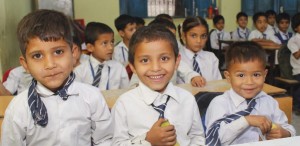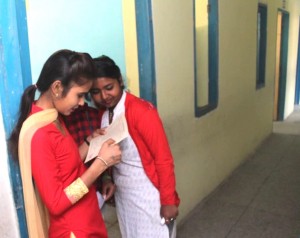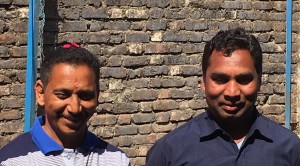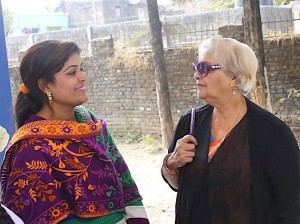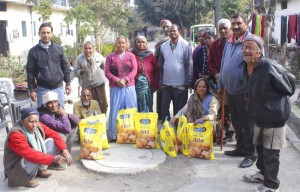Recently, a visitor to LDA asked us some questions. It’s great when we’re asked questions like these because it gives us a chance to talk about KHEL’s history with Ammaji (Mrs. Lalita Arya, KHEL’s Co-Founder), and to record her answers. We enjoyed answering these questions and thought you might enjoy reading our answers (edited for understanding, and donor names removed).
KHEL has been educating kids for 36 years. The kids in the early years didn’t often stay in school for very long, usually just long enough to get a few years of decent meals and milk. Then the girls were married off and the boys sent off to work. Or, the boys would already be working while they were in school. Even now, although our kids are getting educated, they often come from families with illiterate adults, or they’re migrant families, so it’s very challenging to keep track of them. It wasn’t the norm back then in India for kids to stay connected to their elementary schools, so we weren’t in a position to track them after they left us. There was also the stigma of being associated with a ‘charity’ school. Even now, we can only keep track of them when they stay in the community.
When the children leave KHEL, where do they go? What schools have they attended and if you have followed them, what colleges may they have entered?
We started a middle school several years ago, so our kids could continue their education through 8th grade. Since then, all of our kids have gone on to high school. There is no ‘financial aid’ for high school and college the way there is in the US. So, going on to higher education is often limited by the lack of funds. At the college level, the first quarter or semester is never funded even by bank-backed loans, so families have to have the ability to borrow from family for that first part of the first year of college (these families would not have been able to save for this). Once the kids have shown that they can stay in college, some banks will fund them. Their loans start to come due 6 months after graduation, so they are under enormous pressure to find jobs. The banks automatically deduct payment from their paychecks.
When the students have parental permission to go to school, they can afford to go to Government schools only (it’s assumed boys will go to higher education if the family can afford it. This is not assumed for the girls and they often have to fight to stay in high school or go to college). Sometimes KHEL will give financial assistance if it is really needed for transportation, uniforms, and books, but this is a lengthy time commitment for KHEL, and it is challenging to justify putting so much funding into one person when there are so many in need. As India has become more expensive, we are doing this less and less.
For high school and 12th class, students go to MKP Inter College, CNI Boys Inter College, CNI Girls Inter College, and Sharda Public School. For Higher Education MKP PG College, DAV PG College, and DBS PG college.
Ammaji mentioned several success stories. Do you know what jobs they have now?
There are many ex-students doing a variety of jobs. Some have government jobs in healthcare such as lab technicians, nurses, and paramedics. Some have done MBA and are managing companies. There are a few who have done BA and LLB, and now are advocates (lawyers). One female graduate with KHEL’s help got her master’s in science after qualifying as a nurse and is now a Lecturer at HIHT. Some are working in hotels as management in India and abroad. Some students are successful civil contractors, some are fabricators (iron fabrication for fences and roofs, mostly) and some have started other business. Most recently, a graduate of ours opened a stationery shop in a front room of her family’s home. It is everyone’s greatest wish to get a government job since it’s very hard to get fired once such a position is acquired, but these jobs are usually given to someone who knows someone, and there can be literally millions of applicants for a handful of positions. Most people don’t travel too far from home for their jobs, because the languages are different from state to state, so a position advertised in, for example, Kerala, would be challenging for one of our kids to apply for because they don’t speak Malayalam. Young women, especially, are often not allowed to live away from home until they’re married. We’ve had a few young women stand up to their families and simply go off to do what they want, but this is rare. We try as much as possible to support anyone who has been educated by us by using their services and also by giving them guidance in developing their businesses.
Marriages? Other details of their lives after KHEL? Are there second-generation students, the children of former graduates?
Getting married is sort of a requirement for adults in our community. The biggest change is that our young women are delaying getting married so they can have jobs for a while. Usually after marriage they stop working due to pressure from their in-laws. If they continue to work, it must be in a job that doesn’t interfere with them having children or taking care of the household.
Yes, we have second generation kids. But our school is for the poorer community, so once our former students have established themselves, they tend to send their kids to ‘better’ schools, that is, schools that don’t have a reputation as ‘charity’ schools. For example, our two contractors, Rajinder and Jakir, started their own construction companies and sent their kids to more expensive schools. We know this because they do all our construction work and still live in the community, so we’ve stayed in touch with them.
It is difficult to keep track of the women who get married as they usually are partnered with families in faraway villages. The only way we get to see/meet/hear about them is when they visit their parental homes and would drop by LDA to greet their former teachers. I remember one student who after marriage came with her young daughter and enrolled her in our school. She stayed with her parental family for about a year, visiting her married home on holidays with the child. I was very surprised that her husband allowed her to do this, as it’s not the norm for married women of this community to have such freedom. But she was a strong woman in her own way and managed to convince her husband to let her go for a while. She so wanted her daughter to have an experience of the love, care, and education we imparted. But then she eventually had to leave and go back to her married home. I cannot describe her embrace with me when she cried on my shoulder on the last parting. I haven’t seen her since. Maybe some day I’ll tell you the tragic story of how she got married.
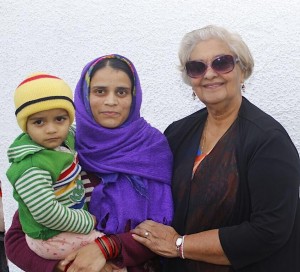
Afsana with Ammaji. Afsana is one of the few women of her generation who stayed in the community after marriage. This was probably due to the fact that she was severely burned as a child in a household accident, and her marriage options were very limited. KHEL paid for her healthcare so that she can have a happy, healthy life.
What is the curriculum at LDA?
LDA follows the established government required school curriculum for lower and middle school. At 5th and 8th grades, there are state final exams so we must prepare the children for these exams. In addition to the state curriculum, we provide extracurricular activities that aren’t required, such as the Adolescent Resource Center (ARC) which provides our older kids with life lessons. In addition, our children are fortunate to get exposure to other cultures through our many visitors and occasionally volunteers. We are supposed to have a science lab but don’t have the space. We have a long-term plan for construction to increase the number of rooms so we can have a library, tech room, and science lab but this is taking many years to complete due to funding constraints. We teach the kids as best we can without these facilities. These subjects are in our syllabus: Nursery to KG: Hindi, English, math as numbers, dance, and art. 1st to 3rd: Hindi, English, math, social studies, dance, and art. 4th to 8th: Hindi, English, math, social studies, dance, art, Sanskrit, science, environmental studies, drawing, crafts, and Yoga.
Is it correct that someone asked for donations to KHEL to buy a buffalo so the children could have fresh milk, way back when? We donated and that is how we found out about the project. When was that, do you remember?
Mr. Chatterjee was the Manager then, but he’s since passed away. This was a long time ago. I don’t remember dates, but it was in the early days of KHEL, maybe even before we were officially a nonprofit. Our Milk & Meals program was part of KHEL’s activities when we started the Project. Maybe between 1983 and 1985? The idea to have our own source of milk production was a very ambitious one. It was suggested because we could not always be sure of the purity of the milk delivered in bulk for the children. As we tried to do it on our own, we found out that keeping a cow/buffalo was more than we could manage. We bought a place, built a cow shelter, and hired someone to handle this job, but it did not last long as it proved more exhaustive and expensive than anticipated. The care for such an animal like feeding, vet charges, security and protection, taking them out to graze, milking them, etc., turned out to be far more extensive a project than we could manage. Eventually we stopped this when the cow fell ill. We had to temporarily cut the milk program as it called for too much extra work/supervision like boiling the raw milk, cooling, distributing, washing up cups, pots and pans, and hiring women to take care of all this. We also ran into the problem that some kids who had never drunk milk could not digest it. What do you do when some kids are slurping away at their cups and some have to sit and watch them? There were other cultural issues with the milk and meals such as how high was the caste of the person making food, but we drew the line with the community regarding this issue because we were not going to discriminate against anyone.
At one other time we also suspended the milk distribution when local packaged milk was found to be tainted with whitewash (this was after it became impossible to get fresh milk in large quantities). When we told the parents we were finally reinstating the milk program, they said to us, we can afford milk now but we really want a middle school. So we worked to provide that. It took a few years and is now flourishing. We have always tried to pay attention to what the community wants us to provide, rather than giving them what we think they need.
What other ways has KHEL stimulated incentive for the cured leper families to integrate into the community and to get so much stronger? It’s been a miracle to watch it all these years, and we used to visit the leper village which would “graduate” healed individuals to go live in the village which was able to leave the riverbed and make a permanent community on the river bank.
Leprosy patients do not ‘integrate’ into society. There are leprosy colonies where cured lepers live because they aren’t welcome in ‘regular’ society, and there is no culture of providing accommodation for physical disabilities. They are unable to find jobs because nobody (except us) will hire them, so they are forced to beg. In recent years, the government has given them much more money, so their lives aren’t as precarious. Leprosy overall has become less stigmatized over the years. The result of this is that there are less new leprosy patients because people are getting treated sooner. Even so, people often will say they’re being treated for Tuberculosis rather than admit that they have Leprosy. This happens occasionally with our school children – because we have regular medical clinics, we can catch these illnesses in their early stages, and we then make sure that our kids stay on their meds for the necessary 15-18 months of treatment. The people you’re thinking about that have left the leprosy colonies that we’ve supported are usually the children of lepers/cured lepers who never contracted leprosy and therefore could integrate. The way they integrate is to hide where they came from. Some of our staff, who prefer to remain anonymous, are from this community. If they reveal their backgrounds, they will be ostracized.
The last large outbreak of Leprosy that I know of happened a decade ago in the mountains. Village women who are illiterate are usually tattooed with their husband’s name when they get married. Many children were suddenly being diagnosed with Leprosy. It turned out that their mothers had been infected by the tattoo needles, and due to their long-term close proximity to their children, the children contracted Leprosy.
In more recent years, our community has become no longer comprised of only people from leprosy related families, but it remains an area where migrants congregate because it backs onto forest land. People can erect shelters in these areas and remain undetected for quite some time. Some of our extended community now have second and third generation established families who are doing quite well for themselves relative to others in the community (this means they have electricity, plumbing, water source in the home, and cement rather than mud floors). Migrants continue to flow through from various parts of the Indian subcontinent for all sorts of reasons, from climate change (flooding and drought), and pricing fixes that have curtailed their traditional farming practices to people fleeing civil unrest due to poverty, Mafia-type activities in their villages, or more mundane reasons such as the lack of jobs. Our area is now represented by City Councilors, and we are proud to say that one of our previous employees, Kamli Bhatt (wife of our General Manager, Beni Bhatt) is a City Councilor.
As long as we are able, we will continue to serve our community so that the children can have access to Kindness, Health, Education, and Laughter. We hope that, whether they stay in touch with us or not, we have made a lasting positive impact on their lives and given them the tools they need to improve their own lives, and the lives of those in their community.
